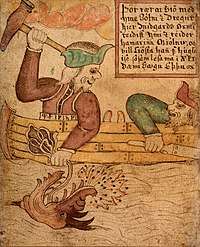Jörmungandr
In Norse mythology, Jörmungandr (Old Norse: Jǫrmungandr, pronounced [ˈjɔrmunˌɡandr̥], meaning "huge monster"[1]), also known as the Midgard (World) Serpent (Old Norse: Miðgarðsormr), is a sea serpent, the middle child of the giantess Angrboða and Loki. According to the Prose Edda, Odin took Loki's three children by Angrboða—the wolf Fenrir, Hel, and Jörmungandr—and tossed Jörmungandr into the great ocean that encircles Midgard.[2] The serpent grew so large that it was able to surround the earth and grasp its own tail.[2] As a result, it received the name of the Midgard Serpent or World Serpent. When it releases its tail, Ragnarök will begin. Jörmungandr's arch-enemy is the thunder-god, Thor. It is an example of an ouroboros.
| Jörmungandr | |
|---|---|
 Jörmungandr gets fished by an ox head, from the 17th century Icelandic manuscript AM 738 4to | |
| Personal information | |
| Parents | Loki and Angrboda |
| Siblings | Fenrir, Hel, Sleipnir |
Sources
The major sources for myths about Jörmungandr are the Prose Edda, the skaldic poem Húsdrápa, and the Eddic poems Hymiskviða and Völuspá. Other sources include kennings in other skaldic poems. For example, in Þórsdrápa, faðir lögseims, "father of the sea-thread", is used as a kenning for Loki. There are also image stones from ancient times depicting the story of Thor fishing for Jörmungandr.
Stories
There are three preserved myths detailing Thor's encounters with Jörmungandr:
Lifting the cat
In one story, Thor encounters the giant king Útgarða-Loki and has to perform deeds for him, one of which is a challenge of Thor's strength. Útgarða-Loki goads Thor into lifting the serpent disguised by magic in the form of a magic colossal cat. Thor grabs the cat around the middle of its belly but is unable to lift such a monstrous creature as Jörmungandr. He manages to raise the cat high enough for only one of its paws to lift from off the floor.[3] Útgarða-Loki expresses how the result was expected and later explains his deception.[3] He acknowledges Thor's lifting of the cat as an impressive deed as he stretched the serpent to where it almost reached the sky. Many watching became fearful when they saw one paw lift off the ground. If Thor had managed to lift the cat completely from the ground, he would have altered the boundaries of the universe.[4]
Thor's fishing trip
Jörmungandr and Thor meet again when Thor goes fishing with the giant Hymir. When Hymir refuses to provide Thor with bait, Thor strikes the head off Hymir's largest ox to use as his bait.[5] They row to a point where Hymir often sat and caught flat fish and where he drew up two whales. Thor demands to go further out to sea and does so despite Hymir's protest.
Thor then prepares a strong line and a large hook and baits it with the ox head, which Jörmungandr bites. Thor pulls the serpent from the water, and the two face one another, Jörmungandr dribbling poison and blood.[5] Hymir goes pale with fear. As Thor grabs his hammer to kill the serpent, the giant cuts the line leaving the serpent to sink beneath the waves and returns to its original position encircling the earth.[5][6] In earlier Scandinavian versions of the myth, Thor successfully captures and kills the serpent by striking it on the head.[7][6]
This encounter with Thor shows to have been one of the most popular motifs in Norse art. Four picture stones that have been believed to have been linked with the myth are the Altuna Runestone, Ardre VIII image stone, the Hørdum stone, and the Gosforth Cross.[8] A stone slab that may be a portion of a second cross at Gosforth also shows a scene of a man fishing for a serpent-like creature using an ox head.[9] These stones did not agree on the myth's conclusion as some had displayed scenes of the serpent escaping by the giant and some of its death.[6] The Ardre VIII stone depicts a man entering a house where an ox is standing, and another scene showing two men using a spear to fish.[10] The image on this stone is dated to the 8th[8] or 9th century.[11] If the stone was correctly interpreted as a depiction of this myth, it would demonstrate that the same of a similar version of the myth remained unchanging for a period of about 500 years prior to the recording of the version in the Prose Edda around the year 1220.[10][7]
Ragnarök
One sign for the coming of Ragnarök is the violent unrest of the sea as Jörmungandr releases its tail from its mouth and thrashes its way onto land. Fenrir will set ablaze one half of the world with fire while Jörmungandr sprays poison to fill the skies and seas of the other half.[12] Fenrir and Jörmungandr will then join the sons of Muspell into the plain of Vigrid.[13] Here is where the last meeting between the serpent and Thor is predicted to occur. Thor will become occupied with battling the serpent and is unable to help others as they fight their own battles. He will eventually kill Jörmungandr but will fall dead after walking nine paces, having been poisoned by the serpent's deadly venom.[14]
Analysis
John Lindow draws a parallel between Jörmungandr's biting of its own tail and the binding of Fenrir, as part of a recurring theme of the bound monster in Norse mythology, where an enemy of the gods is bound but destined to break free at Ragnarok.[15]
Eponym
Asteroid 471926 Jörmungandr was named after the mythological sea serpent.[16] The official naming citation was published by the Minor Planet Center on 25 September 2018 (M.P.C. 111804).[17]
Gallery
_Tors_fiskaf%C3%A4nge_0646.jpg) The Altuna Runestone
The Altuna Runestone Thor goes fishing for the Midgard Serpent in this picture from an 18th-century Icelandic manuscript
Thor goes fishing for the Midgard Serpent in this picture from an 18th-century Icelandic manuscript
 Thor and the Midgard Serpent, Emil Doepler painting.
Thor and the Midgard Serpent, Emil Doepler painting. "The children of Loki" (1920) by Willy Pogany
"The children of Loki" (1920) by Willy Pogany
See also
- Ananta Shesha
- Apep
- Bakunawa
- European dragon
- Horned Serpent
- Lernaean Hydra
- Leviathan
- Makara (Hindu mythology)
- Níðhöggr
- Norse dragon
- Ouroboros
- Sea monster
- Typhon
- Vritra
References
- Rudolf Simek, Dictionary of Northern Mythology (1993)
- Sturluson, Gylfaginning ch. xxxiv, 2008:37.
- Sturluson, Gylfaginning ch. xlvi, xlvii, 2008:52, 54.
- Thury, Eva M. 1, Devinney, Margaret K. 2 (2017). Introduction to Mythology Fourth Edition. New York, USA: Oxford University Press. pp. 302–303. ISBN 978-0-19-026298-3.
- Sturluson, Gylfaginning ch. xlviii, 2008:54-56.
- Acker, Paul 1, Larrington, Carolyne 2 (2016). The Poetic Edda: Essays on Old Norse Mythology. New York, USA: Routledge. pp. 116–118. ISBN 978-0-415-65385-5.
- Ross, Margaret Clunies (1989). "Two of Þórr's Great Fights according to Hymiskviða" (PDF). Leeds Studies in English. 20: 8–10.
- Sørensen 2002:122-123.
- Fee & Leeming 2001:36.
- Sørensen 2002:130.
- Acker, Paul 1, Larrington, Carolyne 2 (2016). The Poetic Edda: Essays on Old Norse Mythology. New York, USA: Routledge. p. 110. ISBN 978-0-415-65385-5.
- Sturluson, Gylfaginning ch. li, 2008:61-62.
- Thury, Eva M.1, Devinney, Margaret K. 2 (2017). Introduction to Mythology Fourth Edition. New York, USA: Oxford University Press. pp. 206–207. ISBN 978-0-19-026298-3.
- Thury, Eva M. 1, Devinney, Margaret K. 2 (2017). Introduction to Mythology Fourth Edition. New York, USA: Oxford University Press. p. 208. ISBN 978-0-19-026298-3.
- Lindow, John (2001). Norse Mythology: A Guide to the Gods, Heroes, Rituals, and Beliefs. New York: Oxford University Press. pp. 82–83. ISBN 0-19-515382-0.
- "471926 Jormungandr (2013 KN6)". Minor Planet Center. Retrieved 17 October 2018.
- "MPC/MPO/MPS Archive". Minor Planet Center. Retrieved 17 October 2018.
Further reading
- Fee, Christopher R.; Leeming, David A. (2001). Gods, Heroes, & Kings: The Battle for Mythic Britain. Oxford University Press. p. 36. ISBN 0-19-513479-6.
- Sørensen, Preben M. (2002). "Þorr's Fishing Expedition (Hymiskviða)". In Acker, Paul; Larrington, Carolyne (eds.). The Poetic Edda: Essays on Old Norse Mythology. Williams, Kirsten (trans.). Routledge. pp. 119–138. ISBN 0-8153-1660-7.
- Snorri Sturluson; Brodeur, Arthur Gilchrist (transl.) (1916). Prose Edda. The American-Scandinavian Foundation.